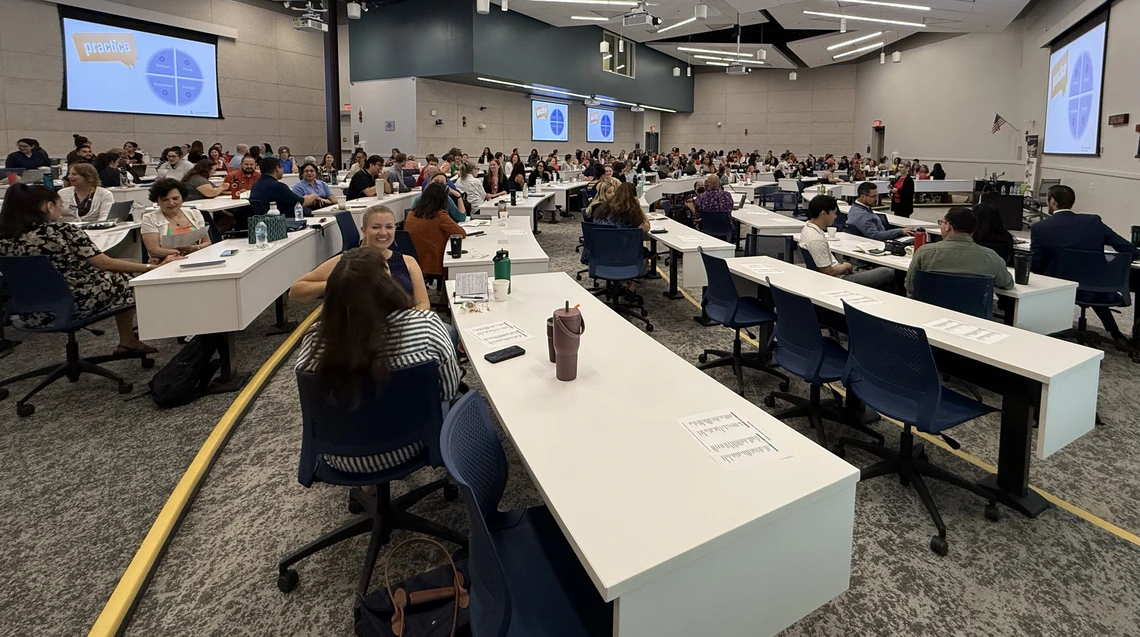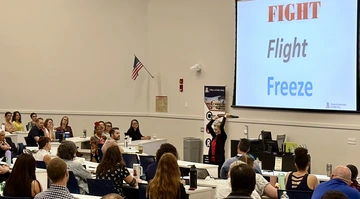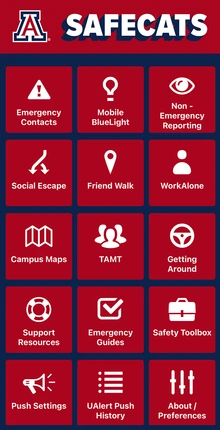Safety takes center stage as a new semester begins

Nearly 200 University of Arizona faculty, staff, and administrators packed the auditorium in The Commons building July 30 for the a day of discussion, discovery and practice of conflict resolution skills. Experts in law enforcement, mental health and higher education led sessions that explored the physiology and psychology behind conflict as well as tools and resources that can help navigate tense interactions.
University Communications/Jason Ground
Nearly 200 University of Arizona faculty and staff members attended the daylong "Conflict Resolution and De-escalation Skills Symposium" on July 30, a strong turnout that reflects the campus community’s commitment to safety as a new semester begins. That commitment is also reflected in the university’s ongoing efforts to enhance campus safety, including training opportunities and the launch of the new SafeCats mobile app.
Finding calm in conflict

Jessie Semmann
The symposium focused on helping employees recognize and diffuse tense situations. Jessie Semmann, director of the Office of Public Safety's Threat Assessment and Management Team, attributed the substantial turnout to an understandable interest among U of A employees in developing skills to recognize potential points of conflict and diffuse them before they become hostilities. Many attendees work in positions that require them to engage with students, parents, alumni and the public at large, and Semmann added that the gathering is relevant beyond the workplace.
"I think it's just a topic that's resonating with people," she said. "They're seeing it in their personal and professional lives. Difficult conversations are around us all the time, and having the skills to navigate tough interactions is something that people feel strongly about."
Symposium sessions covered important aspects of conflict resolution, from the psychology and physiology behind disputes to developing practical tools for navigating tense interactions. The early sessions concentrated on understanding the often-unconscious triggers of conflict. The later sessions expanded on that information and introduced campus resources, trainings and programs.
"The presentations really tried to help show people there's a lot that they can do on their own, but also what to do when they come to a point where it's beyond them, for example a mental health crisis or something simpler, like needing help to have a difficult conversation," Semmann said. "We wanted to make sure that folks left with a feeling of hope for moving forward, and with a better understanding of the campus resources available to help them navigate these situations."

Catherine Tornbom, an adjunct instructor in the School of Government and Public Policy slams a binder on a desk to demonstrate what happens in the brain when someone feels threatened. Tornbom led the first session of the July 30 Conflict Resolution and De-escalation Skills Symposium in the auditorium of The Commons on the University of Arizona campus.
Renee Skau, associate director for student behavioral education in Housing and Residential Life, attended to refresh her conflict resolution skills ahead of the fall semester. She valued Semmann's explanation of the BIFF method – brief, informative, friendly and firm – for handling high-conflict situations and hostile digital communication.
"I think that the information about BIFF responses to digital communication is going to be very beneficial to my team," Skau said. "We try to help students the best that we can, but sometimes they, or their parents, guardians or family members, aren't satisfied with our response, and we receive some emails that could easily escalate into a more tense conflict. I think that using the BIFF method will help address these when they come up."
A situation with a colleague inspired Elvia Lopez to take part in the symposium along with two other staff members from the All of Us research program based at the College of Medicine – Tucson.
"We'd attended conflict resolution programs before, and the techniques we'd learned at those didn't really work in that situation," said Lopez, a senior engagement and retention manager at All of Us. "This will help improve the way we communicate with our staff when conflicts come up. You can never know enough. There's always room to improve."
Build your safety skills

The SafeCats mobile app gives users quick access to safety resources all in one place, including the ability to report concerns directly to the Threat Assessment and Management Team.
Many of the techniques discussed during the symposium are covered in TAMT trainings available through EDGE Learning. "Spotting Trouble: Understanding Targeted Violence" helps participants recognize warning behaviors and understand how TAMT can serve as a resource to understand and prevent targeted violence. "From Conflict to Collaboration: Building Peaceful Relationships" focuses on identifying problematic workplace behavior and using conflict resolution and de-escalation strategies to address difficult situations. Additional safety trainings are outlined in the Office of Public Safety's Wildcat Safety Guide.
The symposium came just weeks before the launch of SafeCats, a new mobile app that gives the campus community quick access to safety resources all in one place, including the ability to report concerns directly to TAMT. The app is now available through Google Play or the Apple App Store.
More information on campus safety is available on the Office of Public Safety website.

